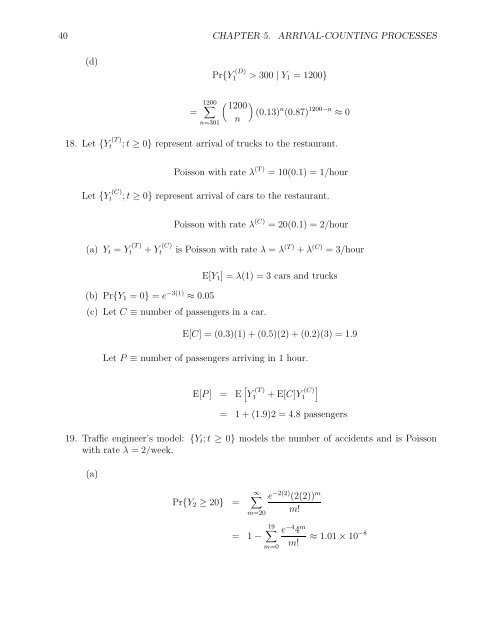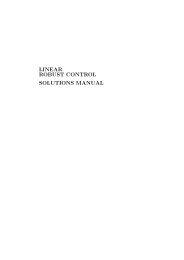SOLUTIONS MANUAL for Stochastic Modeling: Analysis and ...
SOLUTIONS MANUAL for Stochastic Modeling: Analysis and ...
SOLUTIONS MANUAL for Stochastic Modeling: Analysis and ...
Create successful ePaper yourself
Turn your PDF publications into a flip-book with our unique Google optimized e-Paper software.
40 CHAPTER 5. ARRIVAL-COUNTING PROCESSES<br />
(d)<br />
Pr{Y (D)<br />
1 > 300 | Y 1 = 1200}<br />
=<br />
1200 ∑<br />
n=301<br />
( ) 1200<br />
(0.13) n (0.87) 1200−n ≈ 0<br />
n<br />
18. Let {Y (T )<br />
t ; t ≥ 0} represent arrival of trucks to the restaurant.<br />
Poisson with rate λ (T ) = 10(0.1) = 1/hour<br />
Let {Y (C)<br />
t ; t ≥ 0} represent arrival of cars to the restaurant.<br />
Poisson with rate λ (C) = 20(0.1) = 2/hour<br />
(a) Y t = Y (T )<br />
t<br />
+ Y (C)<br />
t<br />
is Poisson with rate λ = λ (T ) + λ (C) =3/hour<br />
E[Y 1 ]=λ(1) = 3 cars <strong>and</strong> trucks<br />
(b) Pr{Y 1 =0} = e −3(1) ≈ 0.05<br />
(c) Let C ≡ number of passengers in a car.<br />
E[C] =(0.3)(1) + (0.5)(2) + (0.2)(3) = 1.9<br />
Let P ≡ number of passengers arriving in 1 hour.<br />
E[P ] = E [ Y (T )<br />
1 +E[C]Y (C) ]<br />
1<br />
= 1+(1.9)2 = 4.8 passengers<br />
19. Traffic engineer’s model: {Y t ; t ≥ 0} models the number of accidents <strong>and</strong> is Poisson<br />
with rate λ = 2/week.<br />
(a)<br />
Pr{Y 2 ≥ 20} =<br />
∞∑ e −2(2) (2(2)) m<br />
m=20<br />
m!<br />
= 1−<br />
19 ∑<br />
m=0<br />
e −4 4 m<br />
≈ 1.01 × 10 −8<br />
m!















